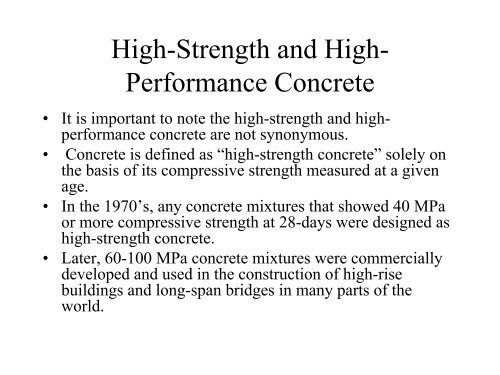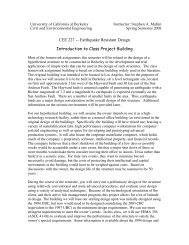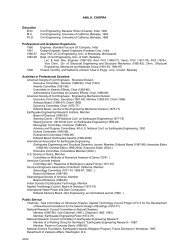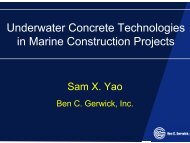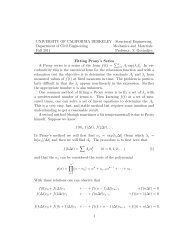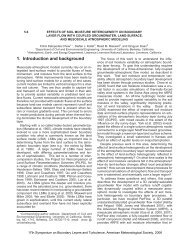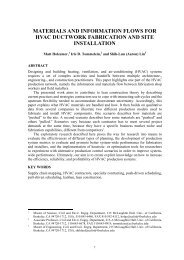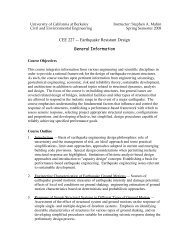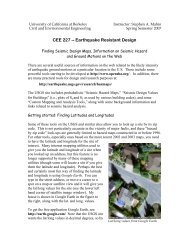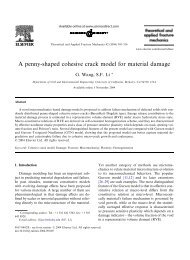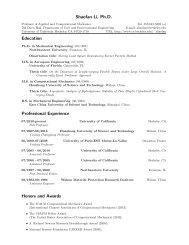High-Strength and High- Performance Concrete
High-Strength and High- Performance Concrete
High-Strength and High- Performance Concrete
You also want an ePaper? Increase the reach of your titles
YUMPU automatically turns print PDFs into web optimized ePapers that Google loves.
<strong>High</strong>-<strong>Strength</strong> <strong>and</strong> <strong>High</strong>-<strong>Performance</strong> <strong>Concrete</strong>• It is important to note the high-strength <strong>and</strong> highperformanceconcrete are not synonymous.• <strong>Concrete</strong> is defined as “high-strength concrete” solely onthe basis of its compressive strength measured at a givenage.• In the 1970’s, any concrete mixtures that showed 40 MPaor more compressive strength at 28-days were designed ashigh-strength concrete.• Later, 60-100 MPa concrete mixtures were commerciallydeveloped <strong>and</strong> used in the construction of high-risebuildings <strong>and</strong> long-span bridges in many parts of theworld.
Definitions• The definition of high-performance concreteis more controversial.• Mehta <strong>and</strong> Aitcin[1] used the term, highperformanceconcrete (HPC) for concretemixtures possessing high workability, highdurability <strong>and</strong> high ultimate strength.[1]
Definitions• ACI defined high-performance concrete asa concrete meeting special combinations ofperformance <strong>and</strong> uniformity requirementsthat cannot always be achieved routinelyusing conventional constituents <strong>and</strong> normalmixing, placing, <strong>and</strong> curing practice.[1]
Typical ClassificationNormal <strong>Strength</strong>20-50 MPa<strong>High</strong> <strong>Strength</strong>50-100 MPaUltra <strong>High</strong> <strong>Strength</strong>100-150 MPaEspecial> 150 MPa
Microstructure
Microstructure• From the general principles behind thedesign of high-strength concrete mixtures, itis apparent that high strengths are madepossible by reducing porosity,inhomogeneity, <strong>and</strong> microcracks in thehydrated cement paste <strong>and</strong> the transitionzone.
Microstructure• The utilization of fine pozzolanic materials in highstrengthconcrete leads to a reduction of the size of thecrystalline compounds, particularly, calcium hydroxide.• Consequently, there is a reduction of the thickness of theinterfacial transition zone in high-strength concrete.• The densification of the interfacial transition zone allowsfor efficient load transfer between the cement mortar <strong>and</strong>the coarse aggregate, contributing to the strength of theconcrete.• For very high-strength concrete where the matrix isextremely dense, a weak aggregate may become the weaklink in concrete strength.
Materials - Cement• Almost any ASTM portl<strong>and</strong> cement type can beused to obtain concrete with adequate rheology<strong>and</strong> with compressive strength up to 60 MPa.• In order to obtain higher strength mixtures whilemaintaining good workability, it is necessary tostudy carefully the cement composition <strong>and</strong>finenesses <strong>and</strong> its compatibility with the chemicaladmixtures.• Experience has shown that low-C3A cementsgenerally produce concrete with improvedrheology.
Materials -- Aggregate• In high-strength concrete, the aggregate plays animportant role on the strength of concrete.• The low-water to cement ratio used in highstrengthconcrete causes densification in both thematrix <strong>and</strong> interfacial transition zone, <strong>and</strong> theaggregate may become the weak link in thedevelopment of the mechanical strength.• Extreme care is necessary, therefore, in theselection of aggregate to be used in very highstrengthconcrete.
Materials -- Aggregate• The particle size distribution of fine aggregate that meetsthe ASTM specifications is adequate for high-strengthconcrete mixtures.• If possible, Aitcin recommends using fine aggregates withhigher fineness modulus (around 3.0). His reasoning is asfollows:– a) high-strength concrete mixtures already have large amounts ofsmall particles of cement <strong>and</strong> pozzolan, therefore fine particles ofaggregate will not improve the workability of the mix;– b) the use of coarser fine aggregates requires less water to obtainthe same workability; <strong>and</strong>– c) during the mixing process, the coarser fine aggregates willgenerate higher shearing stresses that can help prevent floculationof the cement paste.
Guidelines for the selection ofmaterials• The higher the targeted compressive strength, thesmaller the maximum size of coarse aggregate.• Up to 70 MPa compressive strength can beproduced with a good coarse aggregate of amaximum size ranging from 20 to 28 mm.• To produce 100 MPa compressive strengthaggregate with a maximum size of 10 to 20 mmshould be used.• To date, concretes with compressive strengths ofover 125 MPa have been produced, with 10 to 14mm maximum size coarse aggregate.
Guidelines for the selection ofmaterials• Using supplementary cementitious materials, such as blastfurnaceslag, fly ash <strong>and</strong> natural pozzolans, not onlyreduces the production cost of concrete, but also addressesthe slump loss problem.• The optimum substitution level is often determined by theloss in 12- or 24-hour strength that is consideredacceptable, given climatic conditions or the minimumstrength required.• While silica fume is usually not really necessary forcompressive strengths under 70 MPa, most concretemixtures contain it when higher strengths are specified.
Differences Between NSC <strong>and</strong>HSC• In normal strength concrete, the microcracks formwhen the compressive stress reaches ~ 40% of thestrength. The cracks interconnect when the stressreaches 80-90% of the strength• For HSC, Iravani <strong>and</strong> MacGregor reportedlinearity of the stress-strain diagram at 65 to 70,75 to 80 <strong>and</strong> above 85% of the peak load forconcrete with compressive strengths of 65, 95, <strong>and</strong>105 MPa.
Differences Between NSC <strong>and</strong>HSC (2)• The fracture surface in NSC is rough. Thefracture develops along the transition zonebetween the matrix <strong>and</strong> aggregates. Feweraggregate particles are broken.• The fracture surface in HSC is smooth. Thecracks move without discontinuitiesbetween the matrix <strong>and</strong> aggregates.
Mechanical Behavior• Stress-strain curve is more linear• The strain corresponding to the maximumstress increases with strength• The post-peak domain gets steeper• The ultimate deformation decreases with theincreasing strength
<strong>Strength</strong>• Based on 289 observations of moist-curedhigh-strength concrete samples made withType III cement, Mokhtarzadeh <strong>and</strong> Frenchobtained the following relationship[f cm= f c28⎛⎝t0.89 + 0.97t⎞⎠
Long-term strength• Iravani <strong>and</strong> MacGregor suggested the followingstrength values for sustained loading:• 70 to 75% (of the short-time loading strength) for65 MPa concrete• 75 to 80% for 95 MPa concrete, without silicafume• 85 to 90% for 105 MPa concrete, with silica fume• 85 to 90% for 120 MPa concrete, with silica fume
Elastic Modulus• Great care should be taken if using wellestablishedequations developed for normalstrengthconcrete to estimate the elasticmodulus of high-strength concrete.Extrapolation beyond the validity of theequations often leads to overestimation ofthe elastic modulus.
Elastic Modulus• for normal weight concrete with 21 MPa
Data from Tomosawa <strong>and</strong> Noguchi60000Elastic Modulus (MPa)40000200000river gravelCrushed GraywackCrushed QuartzCrushed LimestoneCrushed AndesiteBlast furnace slagCalcined bauxiteCrushed CobbleCrushed BasaltLightweight CALightweight FA + CAModel0 50 100 150 200Compressive <strong>Strength</strong> (MPa)
Chemical <strong>and</strong> Autogeneousshrinkage• During hydration of the cement paste in a closed system,the volume of the hydration products, , is less than the sumof the volume of water <strong>and</strong> the volume of cement that ishydrated. This leads to chemical shrinkage whosemagnitude can be expressed by(ε ch= V c+ V ) w− V hV ci+ V wiwhere <strong>and</strong> are the current <strong>and</strong> initial volume of cement, <strong>and</strong><strong>and</strong> are the current <strong>and</strong> initial volume of water, respectively.
Early Volume Change• Before setting, the chemical shrinkage is notconstrained <strong>and</strong>, therefore, it will induceshrinkage of the same magnitude in thecement paste. As a rigid network ofhydration products starts to develop, thevalues of the chemical shrinkage <strong>and</strong> that ofthe measured shrinkage in the cement pastestart to diverge, since the rigidity of thepaste restrains the deformation.
Definition of the autogenousshrinkage according to the Japanese<strong>Concrete</strong> Institute• macroscopic volume reduction ofcementitious materials when cementhydrates after initial setting. Autogenousshrinkage does not include volume changedue to loss or ingress of substances,temperature variation, <strong>and</strong> application ofan external force <strong>and</strong> restraint.
Concerns with the use of HSC (1)• The lower modulus predicted by designcodes.• (note, not a problem anymore since mostcodes now have adequate equations)
Concerns with the use of HSC (2)• The reported decrease of strength over time.
Concerns with the use of HSC (3)• Fire resistance
Concerns with the use of HSC (4)• Is AE necessary for HSC?
Examples of applicationThe bridge constructed in Joigny usedconcrete with 60 MPa instead ofconcrete with 35 Mpa. The volumeof concrete reduced 30%
Examples of application• Prof. Zia has shown that for 29-m spanswith 80 Mpa concrete instead of 40 Mpaallow a 17% increase in span.
Examples of application• Jobse has demonstrated that by increasingthe compressive strength of concrete from40 Mpa to 70 Mpa the number of supportscould be reduced from nine to four
Petronas Towers
Pertronas Towers• in Kuala Lumpur (Malasia)• 450 m high• 40-80 Mpa concrete• Local workers
Advantages of using HSC in thePetronas Towers• Structural Economy• Efficient method of concrete placement• Simplified construction joints• Reduced vibration due to high wind
Special considerations used inPetronas Towers• Complete study of creep <strong>and</strong> shrinkage• Detailed analysis of wind effect on thestructures. Note that the damping ofconcrete is twice as much as of steel
Construction Stage: Jan.
Construction Stage: Dez.
Construction Stage: March
Construction Stage: June


